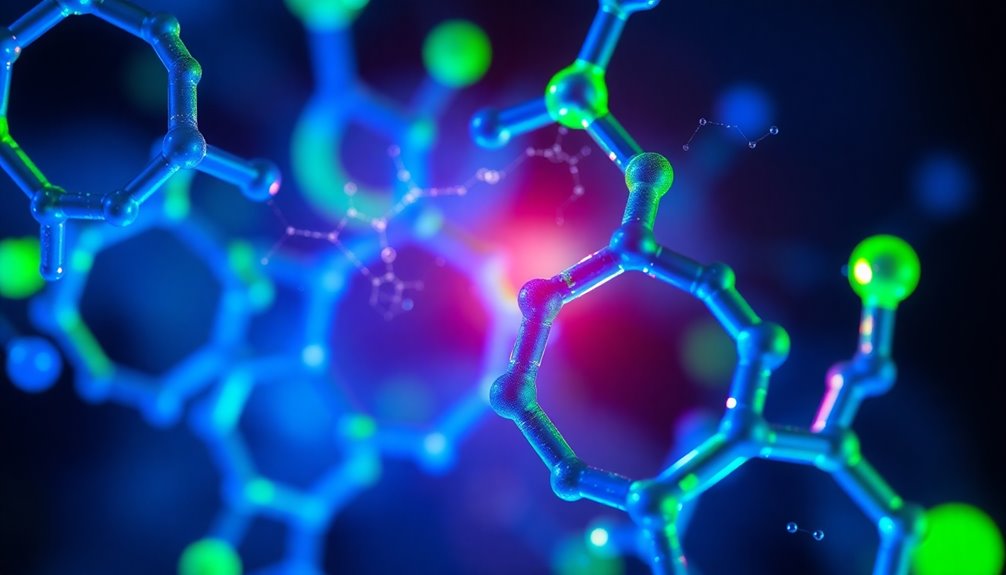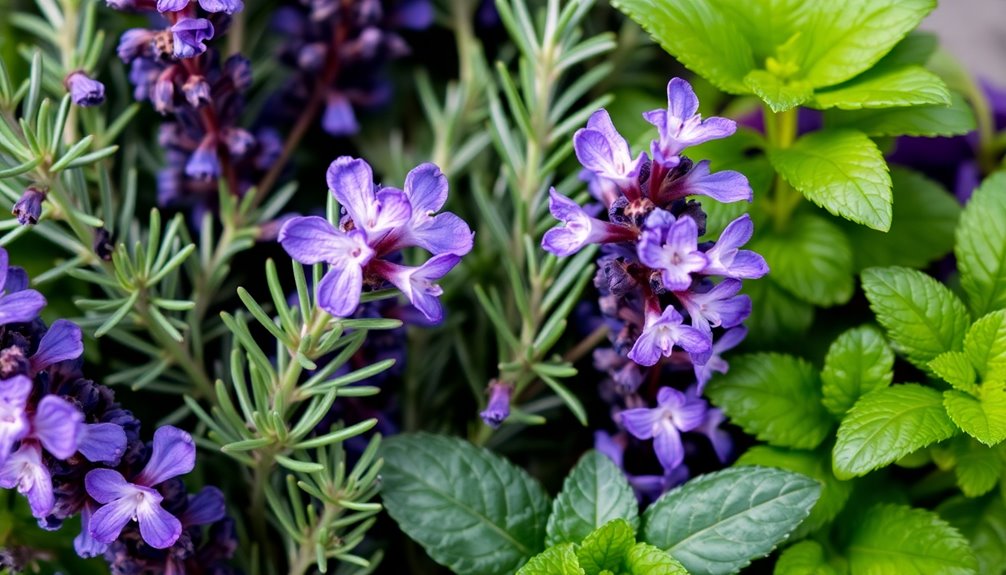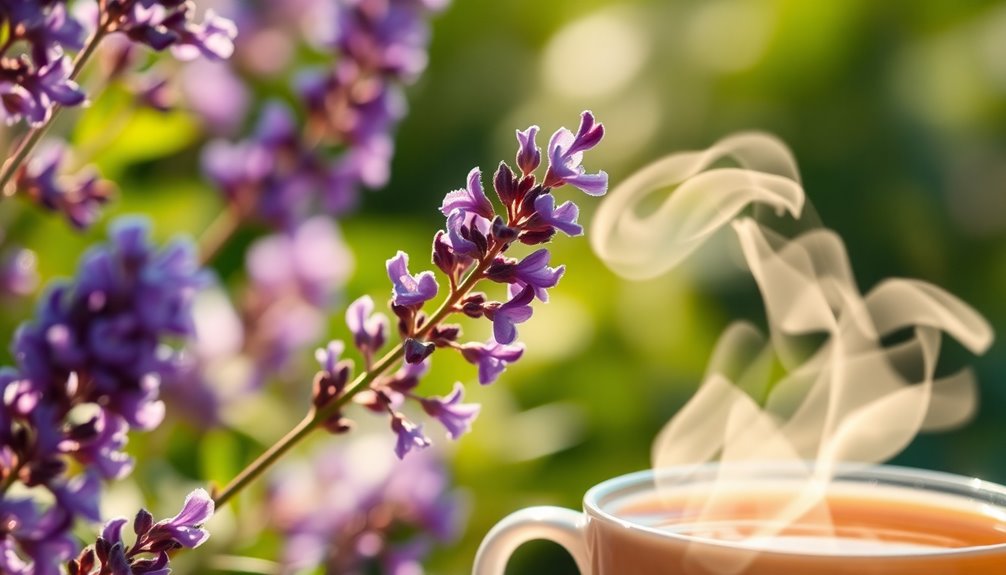Aromatic character refers to the unique stability and properties of cyclic compounds due to the delocalization of π electrons. To achieve aromaticity, a compound must follow Hückel's rule, which states it needs (4n + 2) π electrons. These compounds typically have alternating single and double bonds in a planar structure, allowing for effective overlap of p orbitals. This configuration not only enhances stability but also lowers reactivity compared to non-aromatic compounds. Understanding these foundational aspects of aromatic compounds opens up fascinating insights into their various applications and significance in chemistry and biology.
Key Takeaways
- Aromatic character refers to the stability and unique properties of cyclic compounds due to delocalized π electrons.
- Compounds with (4n + 2) π electrons, as per Hückel's rule, exhibit aromatic character.
- Planar structures with alternating single and double bonds enhance electron delocalization, contributing to aromatic stability.
- Aromatic compounds typically show reduced reactivity compared to non-aromatic compounds due to resonance stabilization.
- Both homocyclic and heterocyclic compounds can possess aromatic character, affecting their chemical properties and applications.
Understanding Aromaticity

When you explore the concept of aromaticity, you'll discover that it revolves around the unique stability and properties of certain cyclic compounds.
Aromatic compounds, like benzene, showcase a cyclic structure that allows for the delocalization of π electrons across the molecule. This delocalization is significant as it leads to resonance structures, enhancing the overall stability of these compounds.
According to Hückel's rule, a compound must have (4n + 2) π electrons to be considered aromatic. The coplanar arrangement of the p orbitals fosters effective overlap, facilitating this delocalization.
Therefore, aromatic character not only reduces reactivity compared to non-aromatic compounds but also plays an essential role in the stability of important biological molecules, such as amino acids and nucleotides.
Significance of Aromatic Compounds

Aromatic compounds are indispensable in various fields, particularly in biochemistry and industry. They play a significant role in your body, with aromatic amino acids like histidine, tryptophan, phenylalanine, and tyrosine supporting protein structure and function. The genetic code relies on aromatic nucleotides, influencing DNA and RNA stabilization. In the chemical industry, aromatic hydrocarbons such as benzene, toluene, and xylene serve as essential raw materials, produced in millions of tonnes annually. Furthermore, many pharmaceuticals derive their efficacy from aromatic structures and delocalized electrons.
| Field | Importance |
|---|---|
| Biochemistry | Critical for protein function |
| Genetic Code | Influences DNA stability |
| Chemical Industry | Key raw materials |
| Pharmaceuticals | Enhances drug efficacy |
Key Characteristics of Aromatic Systems

Understanding the key characteristics of aromatic systems is essential for grasping their unique properties and behaviors. Aromatic compounds feature a cyclic structure with a conjugated system of alternating single and double bonds, which allows for delocalized electrons. This delocalization enhances stability, making aromatic compounds less reactive under normal conditions.
An important aspect is their planar configuration; all atoms in the ring must lie in the same plane to enable effective overlap of p orbitals. According to Huckel's rule, aromatic systems contain (4n + 2) π electrons, ensuring their aromaticity.
Additionally, resonance stabilization means these compounds can't be represented by a single structural formula but as a resonance hybrid of multiple contributing structures, adding to their unique characteristics.
Types of Aromatic Compounds

While exploring the diverse world of aromatic compounds, you'll find they can be categorized into various types based on their structure and composition.
Homocyclic aromatics, like benzene, consist of carbon rings with conjugated double bonds, exhibiting unique aromaticity. On the other hand, heterocyclic compounds include heteroatoms like nitrogen or oxygen, seen in pyridine and furan.
Polycyclic aromatic hydrocarbons (PAHs) feature multiple fused aromatic rings, such as naphthalene and anthracene, which are significant in environmental chemistry.
Substituted aromatics, including toluene and phenol, have functional groups that modify their chemical properties.
Finally, aromatic amino acids like phenylalanine play vital roles in protein synthesis, showcasing the diverse applications of these aromatic compounds in biology and chemistry.
Experimental Evidence and Applications

To explore the fascinating domain of aromatic compounds, researchers rely on various experimental techniques that provide insight into their unique properties.
NMR spectroscopy is a key tool, detecting the distinct magnetic effects of delocalized π electrons in aromatic systems, such as those found in Si56− rings.
The synthesis of Möbius hydrocarbons exemplifies how theoretical concepts can manifest in practice, showcasing aromaticity despite antiaromatic characteristics.
Additionally, studies of non-benzenoid compounds like tropone broaden our understanding of aromatic character beyond classical benzene derivatives.
Research into homoaromaticity reveals that interrupted conjugation can still maintain aromatic character in certain cyclic compounds.
Investigations into the stability and properties of inorganic aromatic analogs, like borabenzene, highlight the diverse applications of aromatic compounds across various fields.
Frequently Asked Questions
What Is Meant by Aromatic Character?
When you explore compounds in chemistry, you'll notice some have unique stability and reactivity patterns. This stability comes from the delocalization of electrons in a cyclic structure, allowing them to be more stable than non-cyclic counterparts.
You'll find that these compounds often prefer substitution reactions instead of additions. Whether in hydrocarbons or heterocycles, this aromatic stability influences their applications in various industries, making them essential in chemical processes.
What Are Aromatic Qualities?
When you think about aromatic qualities, consider their unique stability and resonance.
These compounds, like benzene and toluene, have distinct characteristics due to their cyclic, planar structures and delocalized electrons.
You'll notice they often exhibit lower reactivity and specific solubility properties.
The coplanarity of their atoms allows for effective p orbital overlap, enhancing their aromatic nature, which plays an essential role in various applications in chemistry and materials science.
What Is the Aromatic Character of Urine?
Imagine walking into a room filled with the most bizarre bouquet of scents—urine can be just that!
Its aromatic character comes from a cocktail of compounds, including phenolics and indoles, which create distinct odors.
If you've ever noticed a sweeter smell after indulging in certain foods or during a health issue, that's your body signaling something.
The aromatic profile of your urine can reveal a lot about your metabolism and overall health!
What Is Aromatic Behaviour?
Aromatic behavior refers to the stability and unique properties of certain cyclic compounds due to the delocalization of π electrons.
You'll notice that these compounds often resist addition reactions, preferring substitution instead. This trait helps them maintain their stability.
You might also find that aromatic compounds have distinct odors and exhibit strong interactions, contributing to their ability to form complex structures in various fields, like materials science and biochemistry.
Conclusion
In the world of chemistry, aromatic compounds aren't just molecules; they're the soul of many reactions. Their unique charm and stability offer a comforting embrace to chemists, guiding discoveries and innovations. By appreciating aromaticity, you're not just learning about structures but also connecting with the beauty of nature's designs. So, let this knowledge inspire you, igniting a passion for exploration and creativity in the intricate dance of chemical bonds that surround us.










